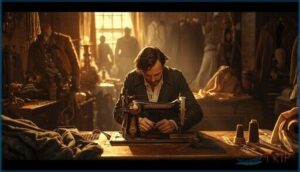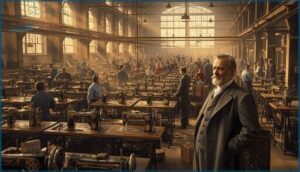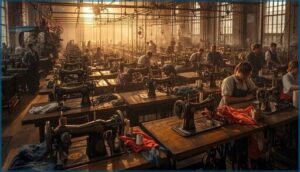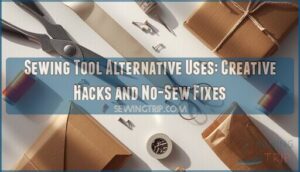This site is supported by our readers. We may earn a commission, at no cost to you, if you purchase through links.
Picture a world where every shirt, dress, and jacket took hours—sometimes days—to stitch by hand. That was reality before a handful of inventors dared to mechanize the art of sewing.
The story behind who made the sewing machine isn’t a neat line from idea to invention—it’s a tangled web of rival claims, courtroom drama, and ingenious breakthroughs. Each name in the saga—Saint, Thimonnier, Howe, Hunt, Singer—added a key piece to the puzzle, turning a slow craft into a force that reshaped industries and daily life.
The race to automate the needle set off a revolution that still ripples through your closet today.
Table Of Contents
- Key Takeaways
- Who Made The Sewing Machine?
- Early Attempts at Sewing Machine Design
- Barthelemy Thimonnier’s Contribution
- Elias Howe’s Lockstitch Breakthrough
- Isaac Singer and The Modern Sewing Machine
- The Sewing Machine’s Impact on Industry
- Societal Effects of The Sewing Machine
- Global Spread and Major Manufacturers
- Lasting Legacy and Modern Developments
- Frequently Asked Questions (FAQs)
- Conclusion
Key Takeaways
- The sewing machine emerged from decades of rivalry, with key breakthroughs from Thomas Saint, Barthelemy Thimonnier, Elias Howe, and Isaac Singer, each building on the last.
- Fierce patent battles and technological leaps turned slow hand-stitching into industrial mass production, slashing garment creation from days to just hours.
- The invention not only powered the rise of textile factories but also transformed daily life, giving women new economic independence and reshaping home and work.
- Today’s sewing machines owe their existence to a blend of mechanical ingenuity, legal drama, and the bold vision of inventors determined to automate the needle.
Who Made The Sewing Machine?
You might think one genius inventor changed everything overnight, but the sewing machine’s origin story isn’t that simple. Multiple innovators across decades contributed pieces of the puzzle, each building on—or battling over—previous designs.
Let’s look at the key players who shaped this groundbreaking tool and trace how their work unfolded over time.
Key Inventors and Their Contributions
You won’t find one inventor behind the sewing machine—this advancement emerged through rebellion and persistence.
- Thomas Saint introduced his 1790 design, the first complete concept for mechanized stitching. Saint’s patent is recognized as the first complete design for a sewing machine.
- Barthelemy Thimonnier brought the chain-stitch machine to life in 1830, facing riots that crushed his workshop.
- Elias Howe Jr. patented the lockstitch in 1846, while Isaac Merritt Singer refined practicality with his treadle-driven improvements in 1851.
Timeline of Invention and Development
Early precursors like Saint’s 1790 concept and Thimonnier’s 1830 chain-stitch model laid the groundwork for the lockstitch emergence through Howe’s 1846 patent. Singer’s improvements arrived in 1851 with treadle drives and presser feet, igniting an industrial impact that slashed shirt-making time from 14.5 hours to one.
Thimonnier’s factory was later subject to destruction by tailors, who feared the machine’s impact on their livelihoods.
Modern machines trace their lineage directly through this sewing machine evolution—a development of sewing machine technology forged by competing visions and legal wars.
Early Attempts at Sewing Machine Design
Before Elias Howe earned his place in history, a handful of inventors were already wrestling with the challenge of mechanizing the needle and thread. These early pioneers laid essential groundwork, even if their designs never quite caught on.
Let’s look at the attempts that set the stage for the sewing machine revolution.
Thomas Saint’s 1790 Prototype
Nearly a century before Elias Howe changed everything, London cabinetmaker Thomas Saint filed British patent No. 1764 in 1790, sketching a leather-stitching machine that defied convention. His chain-stitch mechanism targeted saddles and shoes, not garments.
Key innovations you’ll recognize today:
- Overhanging arm and vertical needle bar
- Feed mechanism for short material lengths
- Looper system anticipating modern designs
The original never survived—only an 1874 reconstruction proved Saint’s Design could actually sew.
Innovations by Walter Hunt and Others
Around 1833, Walter Hunt built New York’s first working lockstitch machine—years before Howe’s patent. Hunt’s invention used two threads interlocking beneath fabric, plus a rotary platform that prevented jams through even feed regulation.
He never filed for patent protection, selling his rights instead. When patent conflicts erupted in the 1850s, officials acknowledged Hunt’s precedence but upheld Howe’s claims, limiting his legacy diffusion despite originating the lockstitch innovation.
Barthelemy Thimonnier’s Contribution
While Thomas Saint sketched ideas on paper, Barthelemy Thimonnier actually built a machine that worked. This French tailor didn’t just tinker in his workshop—he patented a functional chain-stitch sewing machine in 1830 and proved it could handle real production work.
His story reveals both the promise of mechanical innovation and the violent resistance it faced.
The 1830 Chain-Stitch Machine
On July 17, 1830, Barthélemy Thimonnier and Auguste Ferrand secured a French patent for something groundbreaking: a chain-stitch sewing mechanism that used a hooked needle to loop thread through fabric, mimicking tambour embroidery. This early sewing machine invention worked like mechanical poetry, with each stitch pulling through the last to form a chain on one side.
Here’s what made Thimonnier’s machine different:
- Thread technology used a single thread beneath the fabric, not the dual-thread systems you’d see later
- Sewing mechanism relied on a barbed needle descending through material to seize and loop thread upward
- Fabric handling required manual advancement since reliable feed mechanisms hadn’t been invented yet
- Machine efficiency reached about 200 stitches per minute in production variants during the 1840s
- Chain stitch formation created visible loops on one surface and straighter stitches on the other
By 1831, Thimonnier had scaled up his Paris workshop to roughly 80 machines producing French army uniforms—the first machine-based clothing operation.
The wooden frames and metal springs guided each needle movement with spring-return action, making straight seams possible. Sure, the chain stitch could unravel if thread broke, but it was fast and simple enough to launch industrial sewing into reality.
Impact and Challenges Faced in France
At the height of France’s Industrial Revolution, Barthélemy Thimonnier’s innovation met fierce resistance. A French Labor Riot in 1831 destroyed dozens of his chain-stitch machines, halting uniform production and triggering the Chain-Stitch Rejection.
This Thimonnier’s Setback delayed mechanization across the French textile industry, setting back sewing machine adoption just as the rest of Europe and America raced ahead.
Elias Howe’s Lockstitch Breakthrough
Elias Howe’s invention marked a watershed for sewing technology. His lockstitch patent didn’t just change how people sewed—it sparked fierce competition and debate. Here’s what shaped this important chapter.
The 1846 Patent and Its Significance
What set Elias Howe’s 1846 patent apart? It wasn’t just paperwork—it was a blueprint for revolution. His patent specifications locked down the eye-pointed needle and shuttle, forming the lockstitch mechanism that became the industry standard. Here’s why it mattered:
- Eye-pointed needle innovation
- Lockstitch durability
- Automatic feed
- Patent Lawsuit leverage
- Patent pool foundation
Legal Battles Over Sewing Machine Patents
Ever wonder how invention can spark a battlefield? The Patent Wars over sewing machines were a real-life chess match—Elias Howe, Isaac Singer, and rivals locked horns in Sewing Machine Litigation, Royalty Disputes, and heated Court Rulings. Patent Laws and Disputes shaped Intellectual Property forever.
| Inventor | Patent Lawsuit | Royalty Disputes |
|---|---|---|
| Elias Howe | Yes | Yes |
| Isaac Singer | Yes | Yes |
| Wheeler & Wilson | Yes | Yes |
Isaac Singer and The Modern Sewing Machine
Isaac Singer didn’t just build on what came before—he changed the game entirely. His approach set new standards for how sewing machines worked and who could use them.
Here’s how Singer’s innovations and business moves shaped the modern sewing machine you know today.
Improvements on Existing Designs
What made Isaac Merritt Singer’s machine a major innovation? He didn’t just tweak—he transformed. Singer’s lockstitch durability, straight needle innovations, and reliable feed mechanisms set a new standard. His tension control meant fewer thread snarls, while system standardization made repairs and upgrades a breeze. You could finally sew faster, stronger, and smarter—no more wrestling with unreliable, fussy machines.
- Lockstitch durability
- Needle innovations
- Feed mechanisms
- Tension control
Singer’s Commercial Success and Legacy
Imagine a company so dominant it controlled 80% of its market—Singer did just that. Isaac Merritt Singer’s business practices—installment plans, aggressive patent strategy, and global production—turned the Singer Manufacturing Company into an early multinational.
Mass production slashed prices, fueling market dominance. The brand legacy endures today, a symbol of how innovation and bold tactics can reshape entire industries.
The Sewing Machine’s Impact on Industry
The sewing machine didn’t just change how people stitched fabric—it rewired entire industries. Its arrival set off a chain reaction in factories and fashion alike.
Here’s how it reshaped work and production.
Growth of Textile Mills and Factories
By the mid-1800s, mill mechanization wasn’t just a buzzword—it was a revolution. Textile industry giants scaled up, transforming weaving and garment production into powerhouse operations. You saw:
- Factory workforce swelling in regimented shifts
- Productivity trends soaring, especially in cotton mills
- Trade effects rippling as British exports dominated global markets
Structural shifts redefined manufacturing during the Industrial Revolution.
Mass Production of Clothing
With mills humming and workers on the clock, the Industrial Revolution’s new factory systems transformed Clothing Manufacturing. Suddenly, Garment Production wasn’t a slow craft—it was Mass Production on an industrial scale.
Shirts that once took fourteen hours by hand now zipped out in just over one. The Textile Industry embraced Industrial Scaling, reshaping Manufacturing and ready-to-wear fashion for everyone.
Societal Effects of The Sewing Machine
The sewing machine didn’t just change how clothes were made—it reshaped daily life. Its impact stretched far beyond factories and workshops. Here’s how it transformed society, both at home and in the wider world.
Changing Roles for Women
Liberation found its needle in the sewing machine. You gained economic independence, as domestic labor shrank from a marathon to a sprint. Skill development became a badge of honor, reshaping social perceptions and fueling political activism.
The sewing machine transformed women’s lives, turning slow domestic labor into empowerment and opening new paths for independence and skill
Societal changes and sewing intertwined, turning home appliances and consumer goods into tools for the rise of the middle class—and redefining the Cult of Domesticity for women consumers.
Rise of Home and Industrial Sewing
You watched home sewing machines leap from household hobby to pandemic lifeline, fueling a surge in mask-making and creative expression. At the same time, industrial growth and sewing automation transformed the garment industry, driving mass production and precision. E-commerce sewing opened new doors, letting you stitch your way into:
- Microenterprise freedom
- Community resilience
- Groundbreaking creativity
Global Spread and Major Manufacturers
Once the sewing machine took hold, its influence spread far beyond its birthplace. Major manufacturers stepped in, shaping the market and driving innovation.
Let’s take a look at the key players who defined this global industry.
The Singer Company’s Expansion
Ever wondered how the Singer Corporation stitched itself into global dominance? Isaac Merritt Singer’s bold branding strategies, direct sales system, and sprawling manufacturing—from Scotland to Russia—turned the Singer sewing machine into an icon. Postwar changes reshaped its business practices, but the company’s market dominance was built on relentless expansion and innovation.
| Global Manufacturing | Sales System |
|---|---|
| Clydebank Factory | Time-sales, credit |
| Podolsk, Russia | Door-to-door agents |
| Campinas, Brazil | Showrooms |
Other Pioneering Sewing Machine Brands
A world beyond Singer waited to be threaded. Pfaff Innovations fueled European exports, while Bernina History showcased Swiss precision with free-arm zigzag models.
Grover Baker and Wheeler Wilson, powered by Allen Wilson’s rotary hook, shaped American Sewing Machine Evolution.
From Elias Howe’s lockstitch to Barthelemy Thimonnier’s chain-stitch, even the Merrow Sewing Machine Company spun new possibilities for industry.
Lasting Legacy and Modern Developments
The sewing machine’s story didn’t end with its first patent or factory floor. It kept evolving, shaping technology and culture in ways you mightn’t expect.
Here’s how its legacy continues to unfold today.
Technological Innovations in Sewing Machines
What’s driving sewing machine innovations today? You’re looking at a whirlwind of automation integration, servo motors, and computerization. IoT connectivity and AI applications are reshaping sewing technology—think predictive maintenance and real-time analytics.
Modern sewing machine design and engineering now deliver energy-efficient, high-speed, precision stitching. These technological advancements in sewing reflect a bold evolution in sewing machine inventions.
The Sewing Machine’s Ongoing Cultural Impact
The Sewing Machine’s Cultural Impact weaves a thread through Fashion influence, Home sewing, and shifting Gender roles. Your connection to this tool goes beyond utility—it’s about Artistic expression.
Singer machines conquered Global markets, reshaping the Fashion and Clothing Industry after the Industrial Revolution.
Today’s Sewing Technology echoes those waves, reminding you how invention shapes identity and everyday traditions.
Frequently Asked Questions (FAQs)
Are sewing machines made in USA?
You’ll find domestic production today in specialty segments—think Sailrite assembly in Indiana for rugged materials.
But regarding home sewing machines, historical factories have vanished, and import reliance dominates American textile manufacturing and sewing machine manufacturers.
What kind of products can the machine sew?
Whether you’re working with Apparel Production, Upholstery Fabrics, Automotive Textiles, Leather Goods, or Canvas Products, today’s sewing machine manages it all—powering Textile Manufacturing, Fashion and Clothing, and even high-performance technical textiles, no sweat.
What is a sewing machine used for?
With industrial machines generating nearly $6 billion in 2024, sewing machines tackle garment assembly, home textiles, and technical applications alike—delivering precise stitch functionality in everything from mass-produced fashion and home appliances to sophisticated textiles and medical gear.
Who invented the sewing machine?
Early inventors like Thomas Saint, Barthelemy Thimonnier, and Elias Howe battled patent disputes to claim credit for the sewing machine. Howe’s lockstitch mechanism paved the way, while Isaac Singer and Allen Wilson fueled global impact and commercial success.
Who invented the original sewing machine?
The original sewing machine sprang from the hands of early inventors like Thomas Saint, whose 1790 design laid dormant.
But it was Barthelemy Thimonnier’s chain-stitch machine and Elias Howe’s lockstitch mechanism—Howe’s 1846 patent—that made invention history.
Who invented Singer sewing machine and when?
It’s almost poetic—Isaac Singer, not the “first” inventor, but certainly the one who changed everything. Singer’s key innovations, locked into his 1851 patent, powered the modern Singer sewing machine and, after fierce clashes with Elias Howe, built a global market empire.
Who invented the sewing machine in 1890?
No single inventor claimed the sewing machine in That year saw 1890 advancements and incremental refinement, not invention—Singer’s market dominance and industrial maturity reflected earlier breakthroughs.
The patent landscape had shifted from novel ideas to technological advancement.
Who invented the sewing machine in 1842?
Isn’t it odd that the first American sewing machine patent barely stitched its way into history? In 1842, John J. Greenough’s innovation—a short-thread design for leather applications—marked a high point, but saw limited adoption, unlike Howe’s celebrated lockstitch.
Who was the first inventor?
Thomas Saint is the main focus for the first sewing machine invention, thanks to his 1790 British patent.
Saint’s viability stands out before Hunt’s unpatented designs, Thimonnier’s chain-stitch precedence, and the later lockstitch origins sparked legal priority.
What did Elias Howe Jr. do?
Elias Howe reinvented sewing with his 1846 lockstitch patent, fusing technical innovation—a shuttle, eye-pointed needle, and feed—into a reliable machine.
Fierce patent enforcement, courtroom battles over sewing machine patents, and Civil War involvement secured his economic impact and legacy.
Conclusion
By the end of the 19th century, over 5 million sewing machines had been sold—a demonstration of the obsession over who made the sewing machine and the sheer speed at which it changed lives. Each engineer’s vision threaded a different pattern into society.
Today, whether you’re crafting or simply dressing for the day, you carry the legacy of those rebels and dreamers—proof that the answer to “who made the sewing machine” is as varied and surprising as invention itself.
















